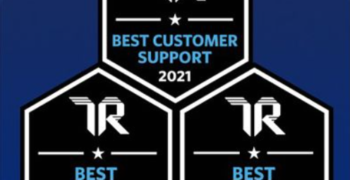A Digital Transformation Strategy for Your Supply Chain
The goal of a supply chain is to deliver the right amount of the right product to the right people using an agile network of partners. The digital supply chain uses data to achieve these goals and overcome today’s challenges. Transforming your supply chain to digital gives you a competitive advantage in customer satisfaction, cost of goods sold, and sales.

Why a Digital Supply Chain?
- Improved demand forecasting—the right amount of product for the right people
- Instant access to the latest released design and manufacturing data—the right product
- Production through supply chain changes—the agile network
- Harmonized partners on products and plans
- Compliance with regulations
- More efficient path to meet your business goals
The digital supply chain uses up-to-date accurate data to plan and respond to today’s realities. Let’s look at how to provide accurate product data.
Start With PLM and QMS
The first step of a supply chain digital transformation is to get control over your engineering and quality processes so that partners can participate. You need a range of ways for your partners to contribute, based on their role in your supply chain and your relationship with them.
Choose a product lifecycle management (PLM) and product-centric quality management system (QMS) that will support your supply chain operations. This accurate, accessible system forms the foundation of a digital supply chain by managing your product and quality processes. Product-centric quality management enables your partners and you to collaborate on improving product quality. ULTRALITE Enterprises is taking these first steps now.
ULTRALITE’s Digital Transformation Journey
Dave Cummings, VP and COO of ULTRALITE, told us about their digital business transformation using PLM and product-centric QMS software. Dave’s background is in telecom, continuously bringing next-generation products to market—from research, product development and product management, to business management. He’s usually working on products 2-3 years ahead of production.
Founded over 40 years ago, ULTRALITE has been proud to offer the safest, most accurate, and most dependable machines on the market. The company provides phototherapy systems to treat a range of skin diseases including psoriasis, atopic eczema, vitiligo, and cutaneous T-cell lymphoma (CTCL).
ULTRALITE provided the first system that digitally administers phototherapy services based on dosage of light. Before this product, physicians had to calculate treatment time based on device output and a patient’s required dosage. The system uses electronic ballasts to control fluorescent lamps and output.
Following the success of their established line of products for hospitals and clinics, ULTRALITE is expanding to offer products for direct patient usage. Until now, ULTRALITE’s engineering and most manufacturing has been in-house. They are now using more partners and are focused on maintaining the same levels of quality and reliability that their customers expect.
Dave joined ULTRALITE to develop and implement a digital transformation strategy that will best deliver their new generation of products to their new customers.
Why Digitize ULTRALITE’s Supply Chain?
First, the new product line is higher volume, so they are growing their capacity using partners. And they need to maintain their high levels of quality even as operations expand beyond their own roof.
Second, ULTRALITE needed to simplify compliance. Design Controls is one of the most cited issues by the FDA. Traceability from Design Inputs to Design Output to Validation is critical to compliance. ULTRALITE needs smoother audits as compared to past successful, but labor-intensive audits.
Finally, ULTRALITE wants to leverage the expertise of partners who are electronic services manufacturers (ESMs). They want to realize the benefits of design for manufacturing (DFM) collaboration. And, like the product quality requirement, they need a compliant quality system that encompasses manufacturing partners.
“As we started developing for the new generation of products that comply with FDA regulations, managing the paperwork became overwhelming. We did not want maintaining compliance to detract from delivering the high-quality product on time.” Dave Cummings, VP and COO, ULTRALITE

Digitalization With PLM and QMS at ULTRALITE
ULTRALITE is taking an iterative approach to using Arena, expanding the system as they meet top priorities. This confidence gained after a success facilitates user buy-in to keep expanding their Arena use.
Basics
Their first step was to manage bills of materials (BOMs) and parts in Arena. They made iterations as they went. For example, after the initial part and BOM upload, they expanded the configuration to include RoHS and REACH compliance information to parts. The documentation (like design specifications) is part of the BOM structure and revision controlled. Now, ULTRALITE’s product information is structured for integration with partner downstream systems.Cross-Functional Collaboration
Next, ULTRALITE implemented online design reviews. In milestone review meetings, the product team uses Arena Scribe to record notes, so it’s linked with the product and easy to find later. They also collect electronic signatures (21 CFR Part 11 compliant) when appropriate. Each signature is time stamped, building the design history file. Product team members appreciate being able to finish this all in the conference room.
Compliant Product Requirement Management
The next step is managing requirements in Arena. During new product development (NPD), teams iterate inputs; they need to track reworked plans, marketing requirements, architecture requirements, and specifications for hardware, software, testing, and packaging easily. They need to provide access to this information for the entire product team. Spreadsheets and documents containing requirements and specifications are time-consuming to maintain, especially at this phase. Using Arena, teams can quickly create requirements and customer inputs using defined templates, link to any parts, reference documents, add details, and keep innovating. Arena maintains traceability through design validation where test results are linked with requirements.
Collaboration With Experts
Another priority is collaborating with their new partners. A benefit of an ESM is the expertise they bring to the OEM. Arena enables communication that helps the ESM add value beyond building the product. For example, an ESM with medical device experience has shared their firsthand knowledge on both compliance and design for manufacturing (DFM). Sharing knowledge makes ULTRALITE value the partner relationship. It really is an advantage over a transactional, arm’s length business model.
Audit Confidence
FDA audits can cause anxiety at medical device companies. ULTRALITE has a long track record of passing audits without findings. With Arena, they are confident in their audit readiness. Answering an auditor’s questions instantly with accurate links and complete history will be easier and faster than searching paper files.Benefits of Digital Transformation With PLM and QMS:
- Efficient new product development
- Leverage partner expertise
- Audit confidence
Digital transformation is a culture change at ULTRALITE, an established, successful company. Using Arena helps everyone get more comfortable as they experience the benefits of these changes. It takes time, but they’re headed in the right direction. Every week, Dave pushes to convert another part of the NPD process into Arena. Arena is the foundation of their new, digital supply chain.
Should You Take the First Step Toward a Digital Supply Chain?
Take inventory of how supply chain fits into your digital transformation strategy. What could you digitize to deliver the most benefits? Product companies find that a digital supply chain yields many benefits. No matter the business reasons for digitizing your supply chain, Arena can provide the foundation you need.
Contact us to take the first steps of your digital transformation strategy for the supply chain.
Arena PLM Wins TrustRadius 2021 Award
Great recognition! Based on verified customer reviews Arena PLM recieves Awards of TrustRadius for Best…
When do you need a PLM System?
All our customers, no matter industry, maturity, or complexity, have had to answer the same…
Our client The Ocean Cleanup wins the Dutch Design Award with The Interceptor in the Category: Product
Dutch Design Award Dutch Design Awards rewards the best Dutch design of the past year….




